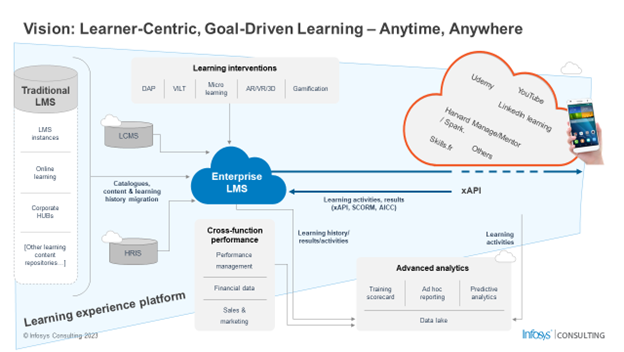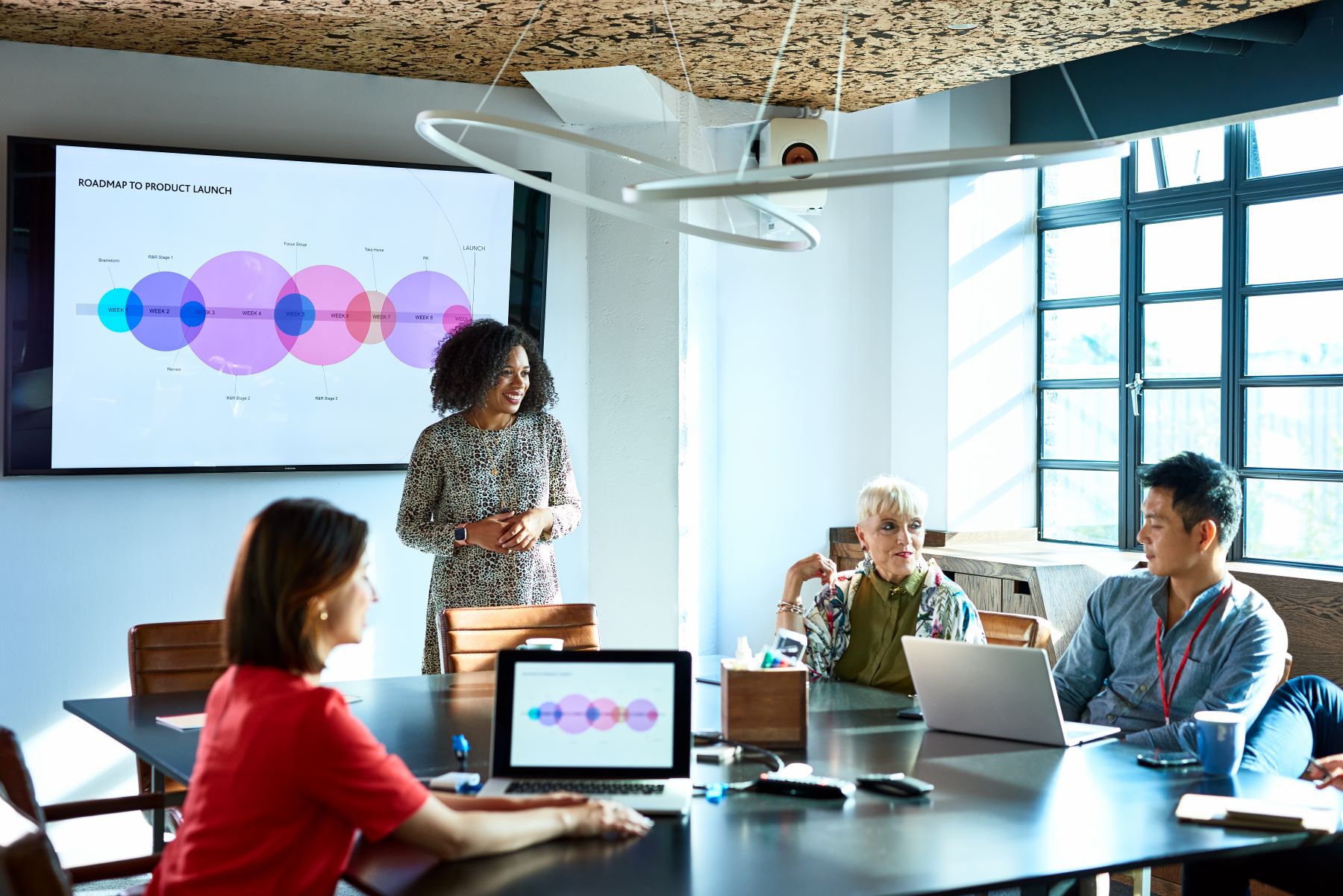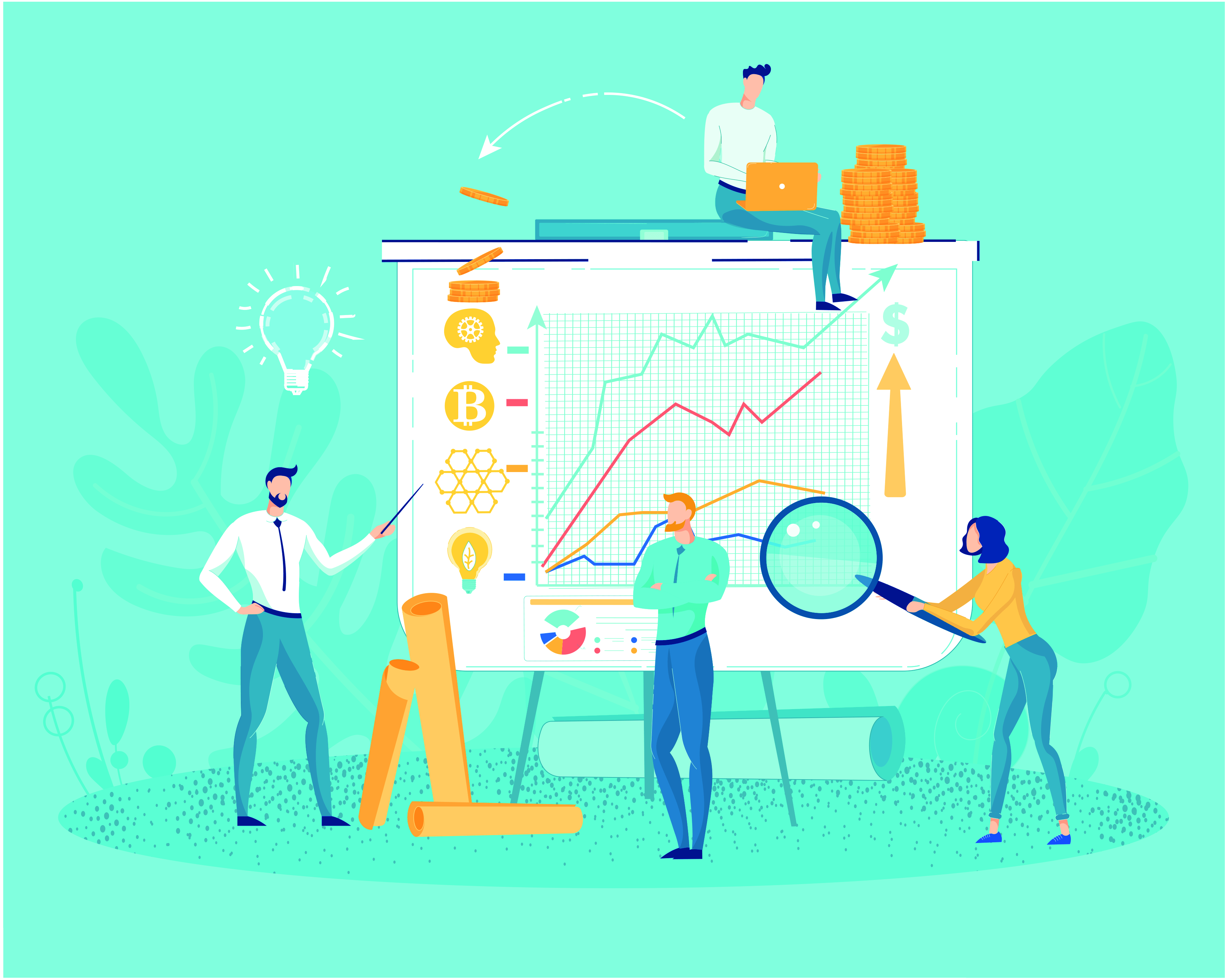Today, markets constantly change and evolve, which means that people and companies must develop alongside the trends to remain relevant and succeed. In Part 4 of our Enterprise L&D series, experts Michael Hendrix, Sagar Likhite, and Rahul Malik explain what a modern learning ecosystem is and how best to implement it.
Organizations are no longer on linear growth paths, instead the workforce is encouraged to embrace exponential growth. Change is the only constant. The way we plan, organize, and deliver services is never the same. Learning is paramount to staying relevant in this changing landscape. Technologies are evolving rapidly at a significant pace and learning must occur in parallel.
These technological advancements, result in:
- Organizational structural changes
- The re-balancing of the workforce across different units
- And the promotion of talent
Consequently, there is a constant need to re-, up-, and build new skills among employees. This ensures that the workforce stays relevant and contributes towards the organization’s business strategy.
Keeping this in mind, how can a business truly become a high-growth organization? The answer: Create a modern learning ecosystem that supports high-growth individuals.
Why is a modern learning ecosystem important to growth?
A company’s ability to grow exponentially and outpace competition hinges on its people and their ability to learn new skills. The learning and development (L&D) organization should go beyond teaching, focusing on enabling employees to perform new skills. These organizations must change the learning culture from passive learners to active and self-directed individuals – eager to learn and apply skills at any opportunity.
L&D organizations have realized the importance of building an efficient and sustainable learning ecosystem, especially when their business is going through a digital transformation journey. The best organizations:
- Have a deep understanding of industry best practices
- Are adept at using and applying modern learning tools
- And, most importantly, can cater the program to different people, recognizing that each person learns differently and at their own pace
As such, to be successful, building a modern learning ecosystem that offers an adaptive approach to training, is vital.
How can technology help?
If implemented well, digital tools can exponentially increase the effectiveness of a L&D program. However, technological advancements don’t unlock learner values or enable desired business outcomes in isolation. The key here is to focus on the “Learner Experience”.
In Part 2 of this series, we explained the strategic shift across industries to focus on enhancing the learner experience. It’s clear, therefore, a business with an optimized learner experience will be well-equipped to compete with and even stay on top of market trends. But what constitutes a best-practice learner experience? Here are some questions to consider:
How easily can employees access learning content?
- Is the training mapped to an individual’s skills and competencies?
- Does the existing learning platform enable employees to define their own learning journeys aligned to their career goals?
- Does the existing learning platform permit learners to easily capture the knowledge gained, and allow knowledge and experience sharing?
Market trends clearly show that the majority of L&D organizations are making investments to create a learning environment that is: learner-centric, goal-driven and available anytime anywhere.
So, the question is, how can businesses create such a learning environment?
Key features of a modern learning ecosystem architecture
Enterprise learning management systems (LMS) still sit at the center of the learning architecture, interfacing with various peripheral systems such as:
Traditional LMS
This includes custom built systems or SaaS solutions.
Content repositories
This is a blend of:
- Traditional Learning: such as instructor, virtual, and web-based training, as well as performance support material
- Modern Learning: which includes micro-learning, gamification, digital adoption platforms, and chatbots, as well as augmented, virtual, and mixed reality (AR/VR/MR)
- Social Learning: such as learning groups, blogs, forums, benchmarking, and social media
Additional business systems
This includes tools such as human resources information system (HRIS) for fetching employee records, as well as performance management systems for employee goals, recognitions, and rewards.
Other additional business systems include financial systems for training budgets and spends. And let’s not forget sales and marketing for tracking results that may have been improved due to upskilling.
Advanced analytics
These are essential for deriving insights.
Third party content publishers
For example: YouTube, LinkedIn, and Udemy. These platforms meet specialized learning requirements.
Clearly, LMS and associated integrations are the foundation to a modern learning architecture. However, as previously stated, no L&D program is effective without taking the learner experience into account.
Learning experience platforms (LXPs) can be layered on top of these core elements to streamline and maximize the employee experience.

What are learning experience platforms?
LXPs deliver targeted content to individuals, rather than focus on one-size-fits-all. This is done by aggregating learning content from multiple sources and using machine learning to generate unique content suggestions. LXPs also enable peer-to-peer learning with ratings, suggestions, and reviews.
Ultimately, they promote learning that facilitates career growth with personalized learning paths. In other words, LXPs bring extended value to existing learning technology architecture by providing a personalized learning experience.
In a conventional scenario, an employee aspiring to develop a particular skill or capability would look for learning pathways within their LMS or even externally. However, with a LXP an employee can:
- See learning journeys designed by other users who are looking to develop the same skillset
- Receive suggestions on how other employees have designed their learning journeys on the same topic
- Get notifications on other relevant sources of learning
- Learn anytime, anywhere – on the go
- Demonstrate learnings in a practice lab environment
- Record all learnings in one place
- Collaborate with other team members and exchange knowledge on the same topic
- Obtain a skill tag on the new skill acquired
Modern learning ecosystem: Some key learnings
Let’s look at some of the key learning experiences that a modern learning ecosystem would provide:
PERSONALIZED LEARNING JOURNEYS
Personalized learning journeys to acquire the aspired skills and learning goals.
Modern LXP systems democratize learning by empowering the user to take charge of their journey. While the organization will recommend a learning journey, the individual is free to customize it to their immediate and long-term needs.
USE OF ARTIFICIAL INTELLIGENCE
Employees can get insights into other employees’ learning journeys and receive recommendations on their desired skills with the help of AI.
For example, when we shop on Amazon, we’re shown a list of similar products that other users have purchased along with the item we’ve just added to our cart. Imagine the same feature for your learning platform – when users attend a training course, the system will give them recommendations for other relevant courses.
AI is one key essential component that makes journeys effective as it helps notify users through push communication on suggested learning journeys. This creates a rewarding user experience and makes the learning environment conducive for continuous learning.
ANYTIME, ANYWHERE LEARNING
Learners have the freedom to define their own personalized learning journeys, accessing learnings anytime, anywhere, and across all device types.
In the deskless learner community, it’s not easy to draw users to classrooms or workstations. Anytime, anywhere device agnostic learning, when coupled with a Netflix-like experience, can make a course almost like a web series to binge.
It also links learning through social media such as external blog sites, twitter handles, and YouTube channels. So, every informal learning source gets recorded against a learner’s profile.
PRACTICE LAB
Once the skills are acquired (or getting acquired), the learner will need an environment to practice their new skills.
A practice lab will allow users to demonstrate their learnings effectively before being deploying them on the job. In other words, it’s a virtual playground for learners to exercise their skills.
USE OF SKILL: TAGS/BADGES
Skill tags and badges for learning completion recognize and reward learners. Badges and tags are automatically added to the user profile.
COMMUNITY AND FORUMS FOR KNOWLEDGE SHARING
A modern learning ecosystem provides a platform to collaborate, share and develop knowledge.
This is possible through the development of communities and forums where employees with common interests and aspirations can exchange, post articles, request, or facilitate training. This then promotes a culture of knowledge sharing.
An efficient modern learning ecosystem, therefore, is an integrated enterprise LMS coupled with a LXP with a centralized data lake. This combination creates a powerful landscape to make corporate learning employee-centric, goal-driven, and available anytime, anywhere.
If you would like to find out more about how to create a modern learning ecosystem, please reach out to our experts.











